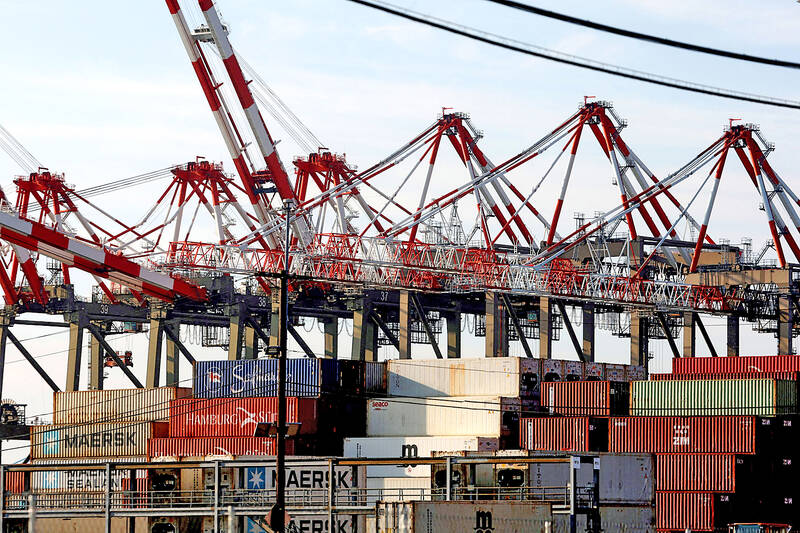A US dockworkers union reached a tentative deal on a new labor contract with a group of ocean carriers and terminal operators that, if ratified, would avoid a shutdown of East and Gulf coast ports next week.
“We are pleased to announce that ILA and USMX have reached a tentative agreement on a new six-year ILA-USMX Master Contract, subject to ratification, thus averting any work stoppage on Jan. 15, 2025,” the International Longshoremen’s Association (ILA) and US Maritime Alliance (USMX) said in a joint statement on Wednesday.
The two sides agreed to continue operating under their contract — which was extended after a three-day strike in October last year shut every major port on the eastern and southern coasts of the US — until the union representatives could vote and USMX members could ratify the terms of the final contract.

Photo: Reuters
The union and employer group had not bargained since November last year, when the ILA declared an impasse over semi-automated cargo handling cranes they said were a threat to union jobs. USMX maintained that new technology, like the cranes, is essential for port modernization and efficiency.
The new agreement would guarantee union jobs when certain technologies are implemented and includes — but is not limited to —the semi-automated cranes that had been a public focal point since November, according to a person familiar with the negotiations. The deal also preserves the 62 percent pay raise agreed to in October and continues to bar fully automated terminals.
“I applaud the dockworkers’ union for delivering a strong contract,” US President Joe Biden said in a statement on Wednesday night. “Their members kept our ports open during the pandemic, as we worked together to unsnarl global supply chains. Thank you to the carriers and port operators who play an essential role in our nation’s economy.”
A deal would mark the end of a contentious fight between the dockworker union and their employers over how certain technology could be implemented at the ports, which handle roughly half of all US container volumes. A strike would have resulted in between US$1 billion to US$5 billion in lost activity each day, according to various forecasts.

When an apartment comes up for rent in Germany’s big cities, hundreds of prospective tenants often queue down the street to view it, but the acute shortage of affordable housing is getting scant attention ahead of today’s snap general election. “Housing is one of the main problems for people, but nobody talks about it, nobody takes it seriously,” said Andreas Ibel, president of Build Europe, an association representing housing developers. Migration and the sluggish economy top the list of voters’ concerns, but analysts say housing policy fails to break through as returns on investment take time to register, making the

‘SILVER LINING’: Although the news caused TSMC to fall on the local market, an analyst said that as tariffs are not set to go into effect until April, there is still time for negotiations US President Donald Trump on Tuesday said that he would likely impose tariffs on semiconductor, automobile and pharmaceutical imports of about 25 percent, with an announcement coming as soon as April 2 in a move that would represent a dramatic widening of the US leader’s trade war. “I probably will tell you that on April 2, but it’ll be in the neighborhood of 25 percent,” Trump told reporters at his Mar-a-Lago club when asked about his plan for auto tariffs. Asked about similar levies on pharmaceutical drugs and semiconductors, the president said that “it’ll be 25 percent and higher, and it’ll

NOT TO WORRY: Some people are concerned funds might continue moving out of the country, but the central bank said financial account outflows are not unusual in Taiwan Taiwan’s outbound investments hit a new high last year due to investments made by contract chipmaker Taiwan Semiconductor Manufacturing Co (TSMC, 台積電) and other major manufacturers to boost global expansion, the central bank said on Thursday. The net increase in outbound investments last year reached a record US$21.05 billion, while the net increase in outbound investments by Taiwanese residents reached a record US$31.98 billion, central bank data showed. Chen Fei-wen (陳斐紋), deputy director of the central bank’s Department of Economic Research, said the increase was largely due to TSMC’s efforts to expand production in the US and Japan. Investments by Vanguard International

WARNING SHOT: The US president has threatened to impose 25 percent tariffs on all imported vehicles, and similar or higher duties on pharmaceuticals and semiconductors US President Donald Trump on Wednesday suggested that a trade deal with China was “possible” — a key target in the US leader’s tariffs policy. The US in 2020 had already agreed to “a great trade deal with China” and a new deal was “possible,” Trump said. Trump said he expected Chinese President Xi Jinping (習近平) to visit the US, without giving a timeline for his trip. Trump also said that he was talking to China about TikTok, as the US seeks to broker a sale of the popular app owned by Chinese firm ByteDance Ltd (字節跳動). Trump last week said that he had